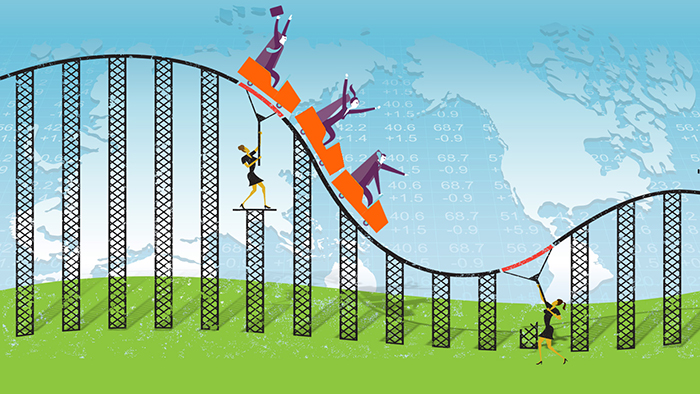up and down
A Wild Ride: Understanding Market VolatilityOn Monday, August 24, 2015, the Dow Jones Industrial Average plunged 1,089 points in the first 10 minutes of trading, the largest intraday point drop in the history of America’s oldest stock index. The benchmark rallied, regaining almost 1,000 points, only to slip again and close down 588 points — the most volatile day in a turbulent stretch that has seen the market bounce around while trending downward.1 As an investor, you might feel nervous about volatility, especially when the trend seems to be heading lower. However, it’s important to consider the reasons behind the market swings and maintain a long-term perspective.
China, Oil, and the Dollar A faltering Chinese economy, including reduced demand for oil, may affect trading partners that depend on exports to China. However, China accounts for only 7% of U.S. exports, and exports are a relatively small sector of the U.S. economy. Low gas prices and a strong dollar are a mixed bag — good for U.S. consumers while challenging for some multinational businesses.2 Balanced against these international issues is a stronger U.S. economy, as well as improving business results. On September 25, the U.S. Bureau of Economic Analysis released its third estimate of second-quarter 2015 economic performance, revising annual real GDP growth from the advance estimate of 2.3% (released before the big market drop) to a more robust 3.9%. Though consumer spending drove the overall increase, the revision also reflected increased business investment. Corporate profits rose at a 3.5% quarterly rate after falling by 5.8% in the first quarter.3 These are strong economic indicators that bode well for the long term, but uncertainty often has an outsized effect on short-term market performance. What Will the Fed Do? In a measure of how interest-rate uncertainty makes investors nervous, the Dow dropped 121 points in four minutes after the Fed announcement and regained 119 points in the next eight minutes. It closed with a modest loss of 65 points or 0.39%.5 New Trading Strategies Maintaining Perspective Some analysts think stocks may have become overvalued during the long bull run, and a pullback or a correction (defined as a market drop of 10% from a previous high) can set a more realistic “floor” for future market growth.8 Fleeing the market during a downturn means you are not in a position to take advantage of growth on the upswing, as many investors learned when they left the market during the recession. In fact, a down market may be a buying opportunity, but it’s just as important to be careful about purchasing investments as it is to be careful about selling. In most cases, it would be wise to maintain a steady course and stick to the sound investment principles you used in building your portfolio. All investments are subject to market fluctuation, risk, and loss of principal. When sold, investments may be worth more or less than their original cost. The S&P 500 index is an unmanaged group of securities that is considered to be representative of U.S. stocks in general. The performance of an unmanaged index is not indicative of the performance of any specific investment. Individuals cannot invest directly in an index. Past performance is no guarantee of future results. Actual results will vary. 1, 8) money.cnn.com, August 24, 2015
The information in this article is not intended as tax or legal advice, and it may not be relied on for the purpose of avoiding any federal tax penalties. You are encouraged to seek tax or legal advice from an independent professional advisor. The content is derived from sources believed to be accurate. Neither the information presented nor any opinion expressed constitutes a solicitation for the purchase or sale of any security. This material was written and prepared by Emerald. Copyright 2015 Emerald Connect, LLC. |
| PrudentProspera.com |
| 5506 Sunol Blvd. suite 205 | • | Pleasanton, CA | • | 94566 |
| Phone: 925-523-3459866-900-8376 | • | Fax: 815-333-3445 |
| www.prudentprospera.com | • | Atul@PrudentProspera.Com |




